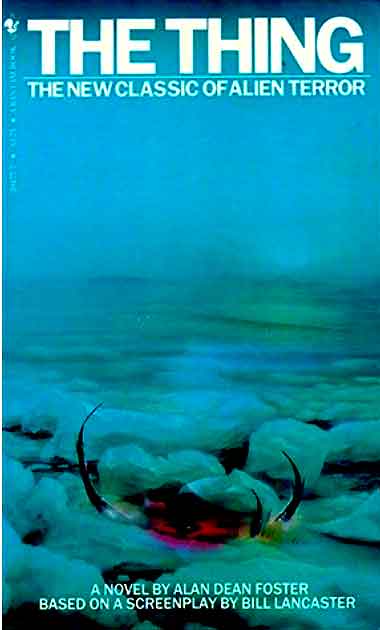 By ALAN DEAN FOSTER (Bantam; 1981)
By ALAN DEAN FOSTER (Bantam; 1981)
A novelization of John Carpenter’s 1982 classic THE THING by the prolific Alan Dean Foster (who also novelized DARK STAR, ALIEN and—pseudonymously—STAR WARS). The text bears quite a few pratfalls common to movie novelizations (oft-hasty prose, perfunctory descriptions, an overall first draft feel) yet is easily the most inspired Foster novelization I’ve read, nicely synthesizing both the Carpenter film and—to a lesser but still-noticeable extent—its inspiration, the 1938 John W. Campbell novella “Who Goes There?”
Another worthy facet of this novel is the fact that it was taken from an early draft of Bill Lancaster’s THING script, and so differs from the finished film in quite a few aspects. Foremost among the latter are Foster’s descriptions of the titular thing, depicted in the film by Rob Bottin’s stunningly imaginative special effects. Clearly those effects were conceived after the screenplay draft Foster used, as the thing in this book tends to exist largely as (to quote an oft-used description) an “indistinct mass of protoplasm.”
The thing, as viewers of the film well know, is a shape-shifting extraterrestrial monstrosity that arrives on a spaceship that crashes in Antarctica. Several million years later the thing is thawed out, and first seen as a dog taken in by a group of scientific researchers stationed at a remote outpost. There the thing expands its repertoire to take the form of the men in the outpost, leading to a toxic atmosphere of fear and distrust—and the now-famous blood test sequence, wherein the men attempt to discover which of them is infected by dipping a heated wire into dishes of each others’ blood.
 In researching this book Foster went above and beyond the call of duty, giving us much factual info about life in Antarctica, where “The winds that torment this empty land make those that sweep over the Rub al Khali seem like spring breezes” and on an average day the sun “peeked hesitantly over the ice and spent a few hours crawling along the horizon until, seemingly exhausted by the effort, it vanished abruptly into the lingering night.”
In researching this book Foster went above and beyond the call of duty, giving us much factual info about life in Antarctica, where “The winds that torment this empty land make those that sweep over the Rub al Khali seem like spring breezes” and on an average day the sun “peeked hesitantly over the ice and spent a few hours crawling along the horizon until, seemingly exhausted by the effort, it vanished abruptly into the lingering night.”
Caught up in this inhospitable environment, the researcher protagonists are going stir crazy. Foster does a fine job depicting the chill and monotony of his characters’ lives, with one guy becoming quite infatuated with his blow-up doll companion (an element that didn’t make it into the finished film).
The horrific action is also generally well handled, although it’s here that the novel’s shortcomings are most evident. The final chapters, wherein the sensational aspects—or “whammies”—increasingly dominate the narrative, simply don’t evince the same care as the more cerebral portions. Yet Alan Dead Foster knew what he was doing, and taken as a whole THE THING is about as lively and well-rounded a novel as can be expected.
